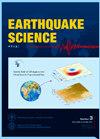合肥2024年9月18日肥东4.7级地震序列构造构造及孕震环境初步研究
IF 4.1
4区 地球科学
Q3 Earth and Planetary Sciences
引用次数: 0
摘要
2024年9月18日20时08分,安徽省合肥市肥东县郯庐断裂带发生4.7级地震。这次地震是合肥近代史上最大的一次地震,造成了巨大的社会影响。为了揭示肥东M4.7级地震序列的发震结构并评估地震风险,我们利用主震前在震中地区部署的永久地震台网和临时密集节点阵数据:(1)准确定位地震序列和确定震源机制;(2)获得地震序列的时空分布、b值和半日发生频率。利用Sentinel-1卫星数据分析同震位移。此外,还利用区域层析成像速度模型和震源区郯鲁断裂带局部高分辨率二维主动源和被动源测量,揭示了发震断层的详细几何形状。结果表明:(1)肥东4.7级地震序列沿一条北西倾、向北东的次垂断裂集中在深度10.5 km左右,长度约为5 km;震源机制解还揭示了承载主震的断层是一条受ENE-WSW区域挤压应力驱动的亚垂直走滑断层;M4.7主震引起的地表同震水平位移最大值接近1 mm;(2)区域速度模型显示震源区vS横向变化明显,主震发生在速度较高的区域;主动源全波形反演得到的高分辨率纵波速度结构和被动源环境噪声层析成像得到的s波速度结构表明,主震发生在高低速体边界,发震断层向北西倾;深层地震反射剖面显示主震发生在侏罗系地层内;(3)基于上述结果,认为肥东M4.7级地震的发震断裂可能是郯庐断裂带主要断裂之一的珠珠—石门山断裂,也可能是其东面的隐伏断裂;北东向的郯庐断裂带与西北西向的肥中断裂带相交,速度变化明显,可能造成局部应力集中,引发肥东4.7级地震序列;(4)肥东4.7级主震后的强烈余震没有进一步扩大断层破裂带;竹竹—石门山断裂的活跃期为早更新世晚期至中更新世,成像结果表明该断裂未穿过肥东凹陷浅层。结合同震破裂面积较小,推断未来地表破裂地震发生的概率相对较低。本文章由计算机程序翻译,如有差异,请以英文原文为准。
Preliminary study of the tectonic structure and seismogenic environment of the M4.7 Feidong earthquake sequence on September 18, 2024 in Hefei
At 20:08, on September 18, 2024, an M4.7 earthquake occurred along the Tanlu fault zone in the Feidong County of Hefei, Anhui Province. This earthquake is the largest event in the modern history of Hefei, which caused substantial social impact. To reveal the seismogenic structure of the M4.7 Feidong earthquake sequence and assess seismic risks, we use data from both the permanent seismic network and a temporary dense nodal array deployed in the epicentral region prior to the mainshock for: (1) accurate location of the earthquake sequence and determination of the focal mechanisms; (2) obtaining the spatiotemporal distribution, b-value, and half-day occurrence frequency of the earthquake sequence. The Sentinel-1 satellite data are used to analyze the coseismic displacement. Additionally, velocity models from regional tomography and local high-resolution 2D active- and passive-source surveys across the Tanlu fault zone in the epicentral area are also used to reveal the detailed geometry of the seismogenic fault. The results indicate: (1) the M4.7 Feidong earthquake sequence is concentrated around 10.5 km in depth along a NW-dipping, subvertical fault which trends NE and is approximately 5 km in length; the focal mechanism solution also reveals that the fault hosting the mainshock is a subvertical strike-slip fault, driven by the regional compressional stress in ENE-WSW; the coseismic horizontal displacement on the surface caused by the M4.7 mainshock has a maximum value close to 1 mm; (2) the regional velocity model shows significant lateral variation in vS in the source region, with the mainshock occurring in the area with higher velocity; high-resolution P-wave velocity structures obtained by full waveform inversion from active sources, and S-wave velocity structures from passive-source ambient noise tomography indicate that the mainshock occurred along the boundary between high- and low-velocity bodies, and the seismogenic fault dips NW; the deep seismic reflection profiling shows that the mainshock occurred within the Jurassic strata; (3) based on these results, we suggest the seismogenic fault for the M4.7 Feidong earthquake is either the Zhuding-Shimenshan fault, one of the major faults in the Tanlu fault zone, or a hidden fault to the east; the intersection of the NE-trending Tanlu fault zone and the WNW-trending Feizhong fault, along with significant velocity variations, likely create local stress concentrations which could have triggered the M4.7 Feidong earthquake sequence; (4) the strong aftershocks following the M4.7 Feidong mainshock did not further extend the fault rupture zone; the active period of the Zhuding-Shimenshan fault was the late Early Pleistocene to Middle Pleistocene, and the imaging results indicate that this fault does not cut through the shallow Feidong depression. In conjunction with the small coseismic rupture area, it is inferred that the probability of surface-rupturing earthquakes in the future is relatively low.
求助全文
通过发布文献求助,成功后即可免费获取论文全文。
去求助
来源期刊

Earthquake Science
GEOCHEMISTRY & GEOPHYSICS-
CiteScore
1.10
自引率
8.30%
发文量
42
审稿时长
3 months
期刊介绍:
Earthquake Science (EQS) aims to publish high-quality, original, peer-reviewed articles on earthquake-related research subjects. It is an English international journal sponsored by the Seismological Society of China and the Institute of Geophysics, China Earthquake Administration.
The topics include, but not limited to, the following
● Seismic sources of all kinds.
● Earth structure at all scales.
● Seismotectonics.
● New methods and theoretical seismology.
● Strong ground motion.
● Seismic phenomena of all kinds.
● Seismic hazards, earthquake forecasting and prediction.
● Seismic instrumentation.
● Significant recent or past seismic events.
● Documentation of recent seismic events or important observations.
● Descriptions of field deployments, new methods, and available software tools.
The types of manuscripts include the following. There is no length requirement, except for the Short Notes.
【Articles】 Original contributions that have not been published elsewhere.
【Short Notes】 Short papers of recent events or topics that warrant rapid peer reviews and publications. Limited to 4 publication pages.
【Rapid Communications】 Significant contributions that warrant rapid peer reviews and publications.
【Review Articles】Review articles are by invitation only. Please contact the editorial office and editors for possible proposals.
【Toolboxes】 Descriptions of novel numerical methods and associated computer codes.
【Data Products】 Documentation of datasets of various kinds that are interested to the community and available for open access (field data, processed data, synthetic data, or models).
【Opinions】Views on important topics and future directions in earthquake science.
【Comments and Replies】Commentaries on a recently published EQS paper is welcome. The authors of the paper commented will be invited to reply. Both the Comment and the Reply are subject to peer review.
 求助内容:
求助内容: 应助结果提醒方式:
应助结果提醒方式:


